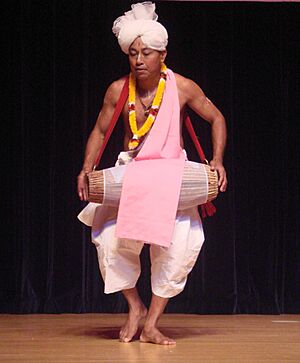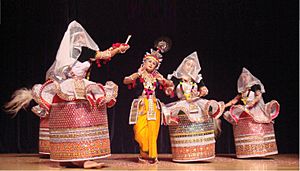Manipuri dance facts for kids
Manipuri dance includes many different dance styles from Manipur, a state in the northeast part of India. The main types are the Laiharaoba, the Samkirtana, and the Rasalila. This classical dance style is known as one of the most graceful of all Indian classical dances. The famous poet Rabindranath Tagore even used this style for the female characters in his dance plays.
Manipur is next to Myanmar. The people of Manipur have a very rich and artistic culture.
Contents
Laiharaoba: A Festival of Gods
The oldest dance style comes from the Lai Haraoba festival. The word Lai means God, and Haraoba means merrymaking. So, Laiharaoba means "merrymaking of the gods." This festival usually lasts for a month, happening every year in May and June.
The Maibis, who are mostly female priests (though some are male), lead the Laiharaoba festival. They follow special rituals. They dance to worship the forest gods, called the Umang Lai. They also worship household gods like Sanamahi or Panthoibi. During their dances, the Maibis show how the Earth and life were formed. They use 364 different hand movements to tell this story! People in Manipur sing, dance, act, play music, and even play sports during the festival. Everyone in the village takes part in these pre-planned rituals.
The main instrument used in Laiharaoba is the Pena. This is a very special instrument from Manipur. A Penakhongba plays it. The music is believed to either put the gods to sleep or wake them up. Other tunes are played for the dances. Stories like Khamba and Thoibi are performed. Other stories feature characters like Nongpokningthou and Panthoibi. These are mostly love stories. People often connect these characters to the Hindu Gods Shiva and Parvati.
Martial Arts in Laiharaoba
Thangpak, a popular martial art from Manipur, is also part of this festival. Performers show off their skills with swords and spears. Many movements from Thangpak are also used in Manipuri dances. For example, the Khujengleibi dance movement comes from a sword technique.
In the 18th century, a branch of Hinduism called Chaitanite Vaishnavism came to Manipur. This religion arrived during the time of King Charairongba. Later, under Raja Bhagyachandra, Chaitanite Vaishnavism became a big part of Manipur's culture. The King joined this religion, and his people followed him.
Many parts of daily life changed with Vaishnavism. People started following its rituals closely. The gods of this religion, Krishna and Radha, were worshipped. Temples were built all over Manipur. People began worshipping the gods through dance. Two new dance forms developed because of this religion: the Samkirtana and the Rasalila.
Samkirtana: Energetic Male Dances
Samkirtana is mainly a male dance form. The dancers play instruments, sing, and dance. This style is similar to the Samkirtana started by Chaitanya Mahaprabhu in Bengal. In Manipur, it has a lot of dance, singing, and instrument playing. It is an energetic and acrobatic dance.
The main instrument is a wooden drum called the Pung. It looks like the clay Khol drum from Bengal, but it makes different sounds. The dance performed with the Pung is called the Pung Cholom. This is a male dance form from Manipur. The name "Cholom" probably comes from "Chalan," meaning "way of movement."
There is also the Kartal Cholom. In this dance, the movements are bigger and follow the sound of large cymbals called Kartalas. The singing, called ishei, is like the kirtana style from Bengal. Singers use a trembling tone, which is special to Manipuri singing. The talas (rhythm patterns) used are very varied. There are 64 different talas for the Pung, and they are used in interesting combinations. The costumes are white, but the turbans of the instrument players are different. Samkirtana is performed at all important events, like birth ceremonies, weddings, and funerals. It is even performed before the Rasalila begins.
Rasalila: The Dance of Devotion
The Rasalila of Manipur is considered one of the most beautiful parts of Indian culture. Through the Rasalila, people in Manipur feel a deep connection to their worship. The first Rasalila Maharas was created in 1779, based on the Srimadbhagavata, a main text of Chaitanite Vaishnavism. The story from the Bhagavata was performed in the temple.
A Rasamandali, which is a circular dance area, was built outside the temple. People sat around it to watch the Rasalila. This still happens at the Govindaji temple, next to the King's Palace. The success of this Rasalila led Raja Bhagyachandra (who ruled from 1755 to 1789) to create other Rasalilas, such as the Vasantarasa and Kunjarasa. The Nityaras and Divarasa were developed later. The Maharasa, Vasantarasa, and Kunjarasa are performed at specific times of the year, but Nityarasa can be performed anytime.
Later kings continued to develop and create dances. Raja Gambhir Singh (1781–1833) added stories of child Krishna in Goparasa and Udukhalrasa. The time of Raja Chandrakirti (1831–1886) is seen as the golden age for the growth of Manipuri dance.
Other Manipuri dances are performed during festivals like Rathayatra, Holi, and Kwakjatra. All these dances are about religious devotion. The songs sung with these dances praise Radha and Krishna. The main instruments used are the Pung and the flute.
Dance Technique
The technique of Manipuri dance is probably the most graceful of all Indian classical dances. The dancer's body moves in a soft, flowing way, often following the shape of the number 8. The feet touch the ground lightly. The face shows a calm expression, and the eyes mostly show bhaktirasa, which is the emotion of devotion.
There are two main styles in this dance form: the tandava and the lasya. In tandava, there is the Cholom tandava performed by men, and the Krishna tandava. The lasya is a very graceful style in Manipur. Rabindranath Tagore used this technique for the female characters in his dance plays.
The emotions in this dance follow the rasa theory from Vaishnava texts. The five main emotions that Manipuri Dance is based on are pancharasa- shanta (peace), dasya (servitude), sakhya (friendship), vatsalya (parental love), and madhura (sweet love).
Manipur stands out from other Indian Classical dances because of the beautiful costumes used in the Rasalila. These costumes are a special creation of the people of Manipur. Religion and art have completely blended in the creation of dance in Manipur. Even today, you cannot imagine Manipuri dance without the presence of the gods Krishna and Radha.
Images for kids
See also
 In Spanish: Manipuri para niños
In Spanish: Manipuri para niños








